FIDE March 2023 rating list published
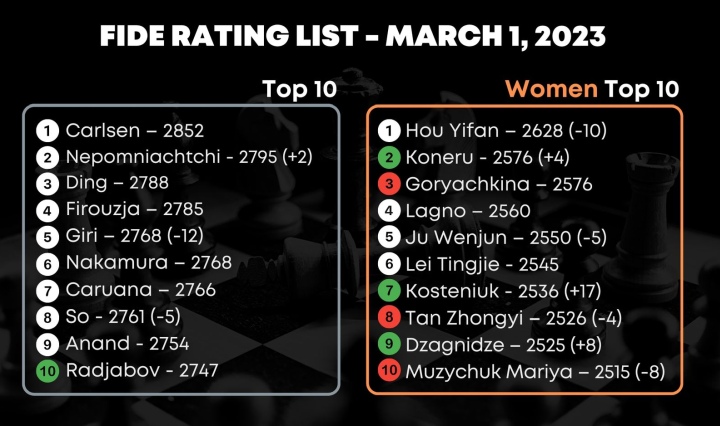
The top ten places in the March 2023 open and women’s lists were mainly affected by the WR Chess Masters in Dusseldorf and the FIDE Women’s Grand Prix Munich, respectively. The only change in the top 10 is the return of Teimour Radjabov. It should also be noted that Anish Giri and Wesley So incurred some rating points losses in Dusseldorf. Ian Nepomniachtchi, who tied for first place in the WR Chess Masters, picked just two rating points, but it was enough to reach his career high of 2795 and consolidate second position in the list. Photo: WR Chess | Lennart Ootes The top-rated female player Hou Yifan dropped 10 points 2022 Chinese Chess League, but her leading position remains incontestable. The winner of the FIDE Women’s Grand Prix Munich, Alexandra Kosteniuk, earned 17 rating points in this competition and jumped to the seventh position in the list. Last time she had climbed that high was almost four years ago, in May of 2019. Photo: Mark Livshitz Nana Dzagnidze turned in a very solid performance in Munich (+8 rating points) and returned to the top 10 Women. Biggest gains in top 100 Open and Women Milliet, Sophie IM FRA 2404(+28) Xiao, Yiyi WGM CHN 2383 (+26) Garifullina, Leya IM FID 2372 (+21) Kosteniuk, Alexandra GM FID 2536 (+17) Saric, Ivan GM CRO 2674 (+13) Gukesh D GM IND 2730 (+12) Paehtz, Elisabeth GM GER 2474 (+10) Bulmaga, Irina IM ROU 2438 (+10) Aronian, Levon GM USA 2745 (+9) Keymer, Vincent GM GER 2699 (+9) IM Sophie Milliet (pictured below) made the biggest progress in February following her strong showing in the Wachtebeke Winter Round Robin 2023 and deservedly won this nomination. WGM Xiao Yiyi fell just two points short, but her rating gain after a strong performance in the Chinese National Team Championship is still very impressive. Photo: Lennart Ootes GM Ivan Saric played in three team competitions in February – Bundesliga, Hungarian Team Superleague and Czech Extraliga – and picked rating points in two of them, thirteen in total. Just like Milliet, another two female players distinguished themselves in open competitions in February. IM Leya Garifullina shared first place at the GM Round Robin RADNICKICHESS, while IM Irina Bulmaga, the only woman in the open section of the Romanian Championship, tied for the fourth position, which translates into +10 rating points. Photo: WR Chess | Lennart Ootes Gukesh D, Levon Aronian and Vincent Keymer are the main rating beneficiaries of the recently completed WR Chess Masters. Consequently, the young Indian debuted in the top 20 Open; the American GM moved up six positions and is now on his way back to top-10, while the German youngster almost returned to a 2700-mark.
FIDE Circuit Leaderboard: Wesley So takes the lead
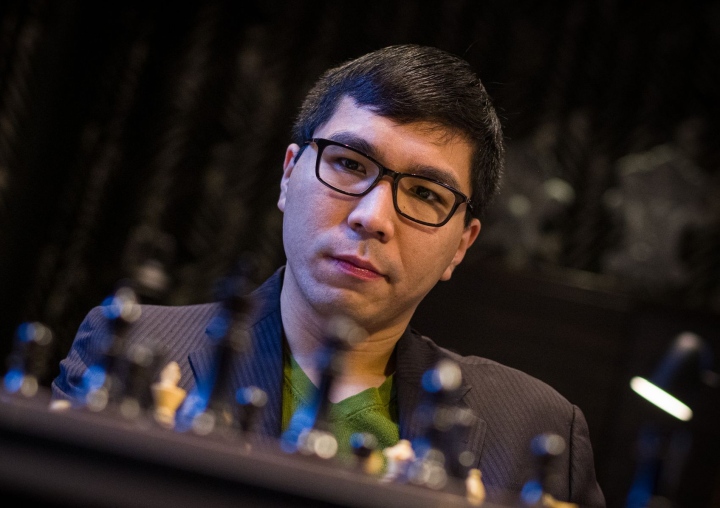
Photo above: WR Chess Masters | Lennart Ootes Wesley So came out on top of the FIDE Circuit Leaderboard in February, edging out the former leader Anish Giri to second place. His tally of 30.8 points is a sum of two solid results (two fourth places) in the two strongest tournaments of the year so far. Levon Aronian (pictured below) soared to third place following his excellent performance at the WR Chess Masters. Photo: WR Chess Masters | Lennart Ootes Another two beneficiaries of this event are Gukesh D and Ian Nepomiachtchi, who tied for first place and broke into the top 10 in the race. As you can see, the top quartet consists exclusively of the players who did well in two points-heavy events in January and February: Tata Steel Masters and WR Chess Masters. Most likely, it will be the case in this race for the spot in the Candidates. Photo: St-Louis Chess Club | Austin Fuller The second tournament that came towards the FIDE Circuit leaderboard in February was the traditional Capelle la Grande in France. Its winner Sethuraman, S.P. (pictured above) picked up 6.5 points, while the runner-up Harsha Bharathakoti earned 5.5 points. Both made their way into the top 20. FIDE Circuit race top 10 as of February 28, 2023 1 So, Wesley 2761 USA 30.80 2 Giri, Anish 2768 NED 29.03 3 Aronian, Levon 2745 USA 26.35 4 Abdusattorov, Nodirbek 2731 UZB 22.28 5 Carlsen, Magnus 2852 NOR 20.25 6 Gukesh D 2730 IND 19.26 7 Nepomniachtchi, Ian 2795 FID 19.26 8 Donchenko, Alexander 2653 GER 13.33 9 Caruana, Fabiano 2766 USA 12.15 10 Maghsoodloo, Parham 2726 IRI 12.15 You can find FIDE Circuit overall standings on ratings.fide.com/circuit.phtml At the end of 2022, FIDE Council approved a major reform of the qualification paths to the Candidates Tournament – the event that decides the challenger for the World Championship match. One of the paths is the newly created FIDE Circuit (Path D). The player accumulating the most points during 2023 in eligible tournaments qualifies for the 2024 Candidates Tournament. The final score is calculated as the sum of the player’s five highest results.
Romanian Championship: Shevchenko and Lehaci win maiden titles
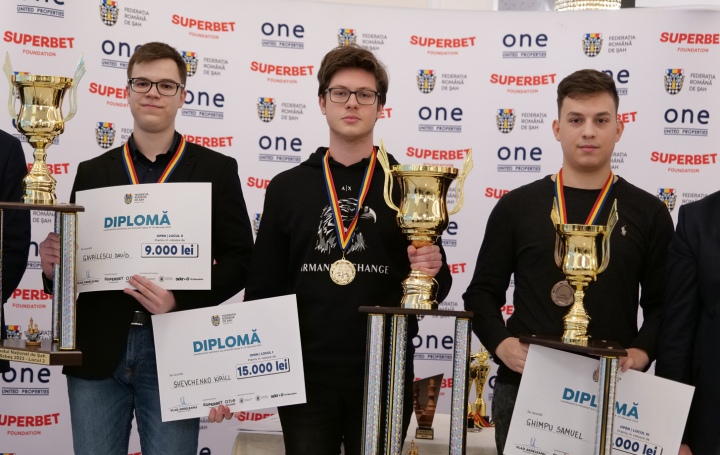
GM Kirill Shevchenko and WIM Miruna-Daria Lehaci are the new champions of Romania. Both won their maiden national titles. The Romanian Championship took place from February 19–26, 2023, in Sebes and saw the triumph of young players. The open, women’s and amateur sections were 9-round Swiss tournaments with classical time control. The third-rated Romanian player Kirill Shevchenko (pictured below), who completed his transfer from the Ukrainian to the Romanian federation last month, sure-footedly confirmed his status as the tournament favourite in the open event. The native of Kyiv scored an impressive 8/9, conceding his opponents just two draws. Two other zoomers, IM David Gavrilescu and FM Samuel-Timotei Ghimpu, tied for second place, netting 6.5/9, with the former claiming silver thanks to a superior Buchholz. The only female player in the open section IM Irina Bulmaga (pictured below) turned in a solid performance and shared fourth place with a large group of players. Final standings Open: 1 GM Shevchenko, Kirill 2662 8 2 IM Gavrilescu, David 2522 6½ 3 FM Ghimpu, Samuel-Timotei 2455 6½ 4 IM Bulmaga, Irina 2428 6 5 IM David, Alexandru-Vasile 2405 6 6 GM Parligras, Mircea-Emilian 2570 6 7 GM Lupulescu, Constantin 2592 6 8 FM Magold, Filip 2324 6 9 GM Jianu, Vlad-Cristian 2518 6 10 GM Szabo, Gergely-Andras-Gyula 2514 6 The women’s championship was a much closer competition as Miruna-Daria Lehaci and WGM Michaela Sandu (both pictured above) took turns leading the field and came to the final round sharing the top position. Lehaci pulled off a crucial victory with the black pieces in a complicated battle with WGM Elena-Luminita Cosma, whereas Sandu suffered a defeat at the hands of the top-rated participant, 12-time national champion IM Corina-Isabela Peptan. With these results, Miruna-Daria Lehaci finished clear first, a full point ahead of four players tied for second place. The second tiebreak variable (Buchholz) favoured Mihaela Sandu, who took silver and WIM Angela Dragomirescu (bronze). Final standings Women: 1 WIM Lehaci, Miruna-Daria 2157 7 2 WGM Sandu, Mihaela 2206 6 3 WIM Dragomirescu, Angela 2113 6 4 WFM Ciolacu, Alessia-Mihaela 2231 6 5 IM Peptan, Corina-Isabela 2351 6 6 WIM Sgircea, Silvia-Raluca 2237 5½ 7 WGM Cosma, Elena-Luminita 2244 5½ 8 WCM Stanciu, Andreea-Briana 1851 5½ 9 WFM Pirvulescu, Ekaterina 2030 5½ 10 WCM Paraschiv, Petronela-Alexandr 1846 5 NM Ion-Cristian Veneteanu emerged as the winner of the amateur section. Photo: Romanian Chess Federation Facebook page
EDU Commission announces its fourth “Preparation of Teachers” course
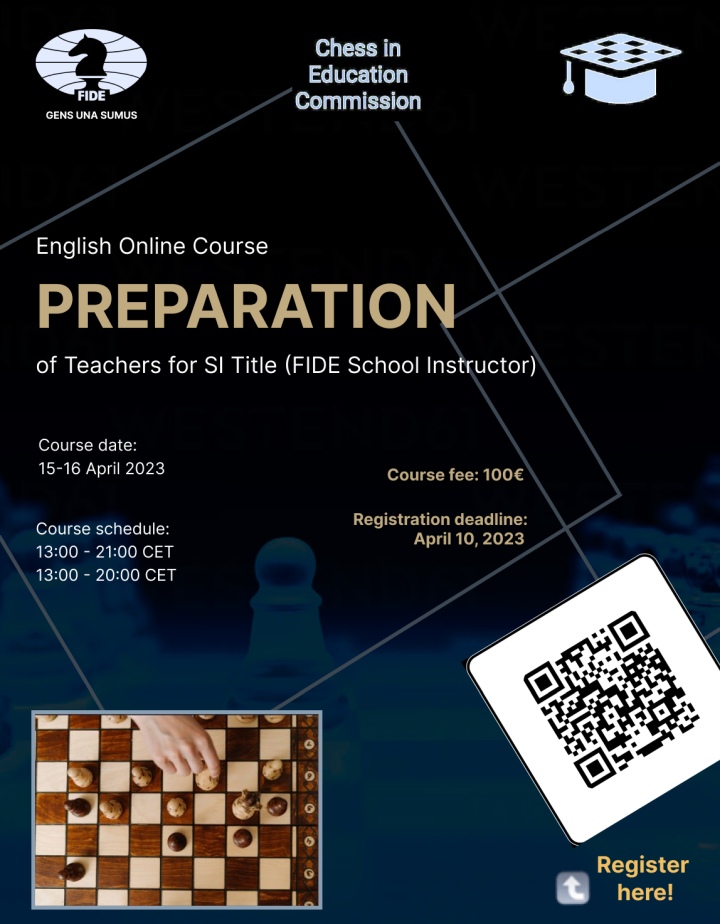
FIDE and its Chess in Education Commission are pleased to announce the dates of the newly revised Preparation of Teachers course. The course will be held online in English from April 15-16, 2023. The target audience is teachers, chess educators, beginner and advanced players with basic chess knowledge and experience working with children. This brand-new course is focused on chess as an educational tool in the classroom. Participants, based upon their exam results, qualify for the FIDE title of School Instructor. Read the detailed course description here. Candidates who wish to attend the course must complete and return the registration form. The cut-off date for applications is April 10. Applicants are accepted on a first-come, first-served basis, and the maximum number of places on the course is 30. If you have any questions, please feel free to contact us at edu.courses@fide.com
WR Chess Masters: Levon Aronian’s tiebreak triumph
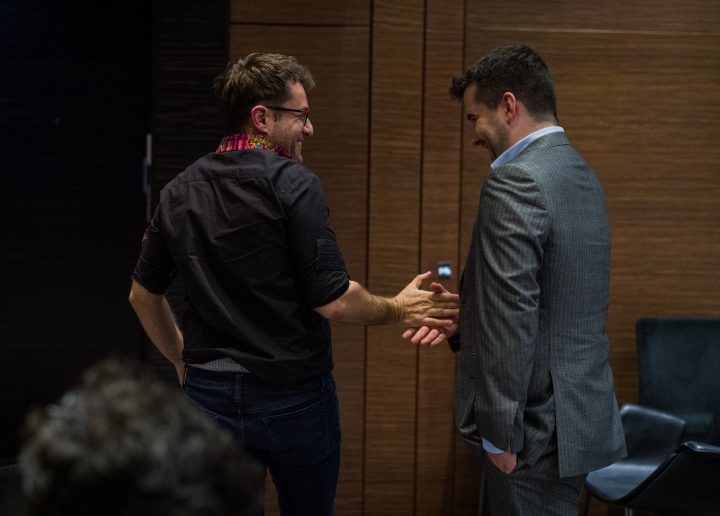
Levon Aronian has won the WR Chess Masters. After Aronian, Gukesh and Ian Nepomniachtchi were tied with 5.5/9 each at the end of the regular distance of nine rounds, Aronian won the tiebreak. He was very happy about the victory, Aronian said. He thanked host Wadim Rosenstein for an excellently organized tournament and the exceptionally good conditions in Düsseldorf, where he had “felt the respect for the players” every day. Levon Aronian with the winner’s trophy. | Photo: Lennart Ootes Predicting the first and last finished games of the ninth round wasn’t too difficult. In their tournament game, the supposed showdown, co-leaders Levon Aronian and Gukesh were not looking for a fight to the death. In a well-known variation of the Ragozin, both opponents headed straight for a repetition that many grandmasters have used to quickly split the point. The two had thus postponed the decision about the tournament victory and who would win the first prize of 40,000 euros and the trophy to the tiebreak – and risked Ian Nepomniachtchi disputing this prize. But before Nepomniachtchi got the chance to do so, he had to win against Vincent Keymer. The World Championship finalist needed a full point to catch up with Gukesh and Aronian. After six hours and 82 moves, Ian Neponiachtchi defeated Vincent Keymer. | Photo: Lennart Ootes While all the other games of the day gradually petered out, Vincent Keymer once again had to put in a six-hour shift. Opposite of him, Nepo didn’t let up, looking for opportunities to sharpen things up even with reduced material. For five hours, Keymer kept the position balanced, then he rashly let his passed pawn run, and it was over: On the other wing, Nepomniachtchi’s play against the white king would prove decisive, while Kemer’s passed pawn didn’t reach the eighth rank. Nepomniachtchi had managed to catch up with Aronian and Gukesh on the home stretch. Three players tied at the top of the table – a rarity, but it happens. Levon Aronian has experience with this situation: back in 2018, at the Sinquefield Cup in Saint Louis, he, Magnus Carlsen and Fabiano Caruana ended up at the top with equal points. A drawing of lots was scheduled there – and the players negotiated it away at short notice. They preferred to share first place. Such negotiations were not planned in Düsseldorf, and they did not arise. The rules in the event of a tie at the top of the table were clear. So where do we go from here? | Photo: Lennart Ootes Nepomniachtchi, after his hard-fought victory over Keymer, nevertheless first had to ask main referee Gregor Johann how things would proceed. “A round robin, double round robin, 10+2,” he got in reply. After an 82-move and more than 6-hour tournament game, he was now to face a potentially more than five-hour playoff against two rested opponents. After winning the first tiebreak game against Gukesh, Aronian added another win in the second against Nepo. Nepomniachtchi seemed to have created nice attacking chances but had made structural concessions. And these weighed heavier. After that, Nepomniachtchi had to play again, this time against Gukesh, and it was already a decisive game. Only the winner would still have a chance to challenge Levon Aronian for the tiebreaker. It went back and forth, with both having chances, and in the end, the Indian prevailed. That gave him a must-win game against Aronian: now, one more win and the youngest competitor would be back on the heels of the oldest. It started well for Gukesh, who first smashed up Aronian’s structure, then took aim at some pawn weaknesses and seemed to be on the winning track with two extra pawns. But Aronian didn’t let up, continuously creating problems, and Gukesh failed to turn his big advantage into a decisive one. In the end, the game turned completely around. After these three full points in a row, Aronian could no longer be denied the tournament victory. The last two games of the tiebreak were not played. The youngest and the oldest participant before the last game of the tournament. | Photo: Lennart Ootes More photos and interviews in the tournament feed Text: Official website Photo: Lennart Ootes Offical website: wr-chess.com/
WR Chess Masters: Three candidates for tournament victory
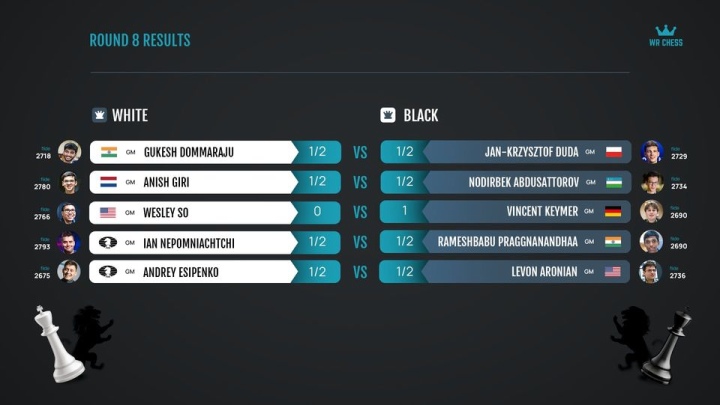
Showdown with Joker: After eight rounds of the WR Chess Masters, the field is set for an exciting final round, in which the two leaders on equal points, Gukesh and Levon Aronian, meet. Half a point behind them lurks Ian Nepomniachtchi, who can still catch up in the event of a draw between the two. To do so, however, he’ll have to beat Vincent Keymer, who is in increasingly good form. Keymer defeated Wesley So in the eighth round. With this loss, the previously undefeated US grandmaster was eliminated early from the fight for the first prize. So versus Keymer was the only decisive outcome of the day. Over 2700 Elo again: Now that it’s almost over, Vincent Keymer seems to have really arrived. | Photo: Lennart Ootes Keymer, back in the 2700-Elo club, expressed his relief after the game. “Super happy” he was with this victory over one of the very best in world chess. “Wesley So in top form is on a par with Magnus Carlsen, a hugely strong player,” explained Keymer, who has now climbed from “minus 2” to 50 percent. However, if someone were to offer him to play a second round of nine now, given his good results recently, Keymer would hesitate: “Don’t underestimate the energy that such strong competition takes.” The WR Chess Masters makes very different demands than a “normal” tournament with “normal” opponents, he said. “There is no relaxed moment here.” If the opponents are not world-class, “then you just make normal moves, which may not always be precise, and you don’t get punished. It’s very different here.” Speaking to Yasser Seirawan, Keymer recalled his black game against Jan-Krzysztof Duda: “I allowed myself one inaccuracy, and then as punishment, I had to sit and defend for 6.5 hours.” Levon Aronian demonstrated in the eighth round against Andrey Esipenko not his best chess but his chess psychological extra class. In a game in which he thought he had no chance after an opening mistake, Aronian sent a perfectly timed draw offer across the board – just at the moment when he had built up a little counterplay, and Esipenko was threatening to run out of time. Now the 20-year-old had to deal with not only Aronian’s activity during his ticking-down seconds but also the question: “To accept or not?” Esipenko accepted, and Aronian was happy to have escaped. Cheating control with a magnet: If Andrey Esipenko wore a button in his ear, the magnet would pull it out. | Photo: Lennart Ootes Nodirbek Abdusattorov got away with an opening mistake in a classical Sicilian, with which he wanted to surprise Anish Giri. But the latter was prepared. “I can’t explain it exactly, but somehow I guessed what Nodirbek would play,” the world number five said after the game. What happened to Giri was what he believes happens to him too often: After catching his opponent thanks to superior opening preparation, he let him escape into a draw. “That was unfortunate, of course,” Giri said. Gukesh will play for the tournament title on Saturday. | Photo: Lennart Ootes Gukesh had his eyes on two boards during his battle with Jan-Krzysztof Duda. Tied with Levon Aronian at the top of the table, “of course, I followed how he was doing.” But even when Aronian was supposedly on the losing side, “it didn’t affect my game”. Now Gukesh is looking forward to the showdown in the ninth round. “Levon is a great player, for sure it will be an interesting match. I’m excited about it.” Praggnanandhaa experienced a déjà vu with the black pieces – almost. Just two weeks ago in Wijk aan Zee, he had beaten the World Championship finalist Ding Liren with black in an Italian game. Now he was facing Ian Nepomniachtchi, the other World Championship finalist, in Düsseldorf, and once again, the Italian was on the board. However, the game went the other way. Nepomniachtchi, encouraged by his win the day before, put on the pressure to catch up with the two leaders if possible. Pragg, however, defended with precision and came away with a perpetual check and half a point. Ian Nepomniachtchi put the pressure on but couldn’t get through. | Photo: Lennart Ootes More photos and interviews in the tournament feed Text: Official website Photo: Lennart Ootes Offical website: wr-chess.com/
WR Chess Masters Round 7: Gukesh catches up with Aronian
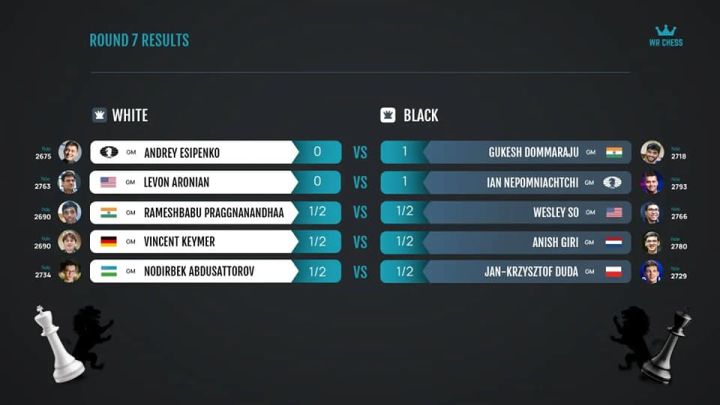
Gukesh has caught up with Levon Aronian. After a Black win over Andrey Esipenko in the seventh round of the WR Chess Masters, the youngest competitor now shares the top spot with the oldest on 4.5 points. The two will meet in the ninth and final round, potentially a showdown for the tournament title. Heading for a showdown to win the tournament? Gukesh, twice. | Photo: Lennart Ootes Aronian lost to Ian Nepomniachtchi, who managed to break his run of drawn games. With four points from seven, the upcoming World Championship finalist is hot on the heels of the two leaders and in a good position to win the tournament himself. Levon Aronian’s queen had lost its way a bit on the wing named after it with no discernible task and no quick way back, one reason why Nepomniachtchi was satisfied with his position early on. Alone: he had used up a lot of time. On the other hand, the exposed position of the opponent’s queen gave him the opportunity to chase it back and forth, thus repeating moves without changing the position. After the first back and forth, Aronian suddenly called arbiter Gregor Johann to the board and claimed a draw because of a threefold repetition. But Aronian had miscounted. Johann ordered the game to continue. When Ian Nepomniachtchi realized how much Levon Aronian wanted a draw, he decided to play on and was rewarded. | Photo: Lennart Ootes “When Levon even went for the arbiter to get a draw, I saw how big his desire for a draw was,” Nepomniachtchi explained after the game. And he named another argument to continue the game: “I don’t have so many classical games before the World Championship match. I should use them.” And how he used this one. With the white queen locked out on the other wing, Nepomniachtchi launched an attack against the under-defended white king. Gradually, he managed to bring more and more forces into position against Aronian’s monarch. After Aronian missed one or two opportunities to raise counterplay, the black initiative became irresistible. Form exchange: There was a form on the board that started at move 61, not move 1. Arbiter Thsepiso Lopang corrected the matter. | Photo: Lennart Ootes The second Black victory, not only of the round but of the tournament, came to Gukesh, although it didn’t look like it at first. In a Catalan gambit, the Indian was on his own early – unlike his opponent. “He’s prepared, it’s probably quite dangerous for me,” Gukesh reflected during the opening. “But I’m proud of what I then found on the board.” A knight move that was actually offside looked terrible at first glance but was tactically and strategically justified in these specific circumstances. Nevertheless, it looked as if Esipenko was gradually organizing a promising king attack. But Gukesh coolly fended off what came, and he was still playing on the other side of the board with the extra pawn Esipenko had sacrificed at the start of the game. The white attack petered out, and the black counterattack soon took hold. Wesley So and Praggnanandhaa provided the marathon of the day. For over seven hours, So pressed for the full point with the black pieces. The Indian defended flawlessly in the rook ending until after 82 moves, there was only one rook each left on the board. The most spectacular game of the day seemed to be played by Nodirbek Abdusattorov and Jan-Krzysztof Duda. Already on move seven, Black’s king had to flee to g6 into the open field, but one move later, a black knight snatched a white rook on h1. But what looked wild and hardly transparent was known to both players. Both had embarked on a rare line of the Steinitz Attack in the Petrov Defense, and both knew exactly what they were doing. The spectacle soon petered out into a roughly even endgame. Pawn c4? Sebastian Siebrecht provides guidance to Düsseldorf’s head of sports Britta Zur on how to execute the ceremonial opening move. | Photo: Lennart Ootes Vincent Keymer and Anish Giri also had such an endgame on the board very early on. Keymer claimed possession of a pawn, Giri had greater activity and a better pawn structure. The result was an even game. More photos and interviews in the tournament feed Text: Official website Photo: Lennart Ootes Offical website: wr-chess.com/
Wissmann wins in Finland, solvers move to Poland and Netherlands
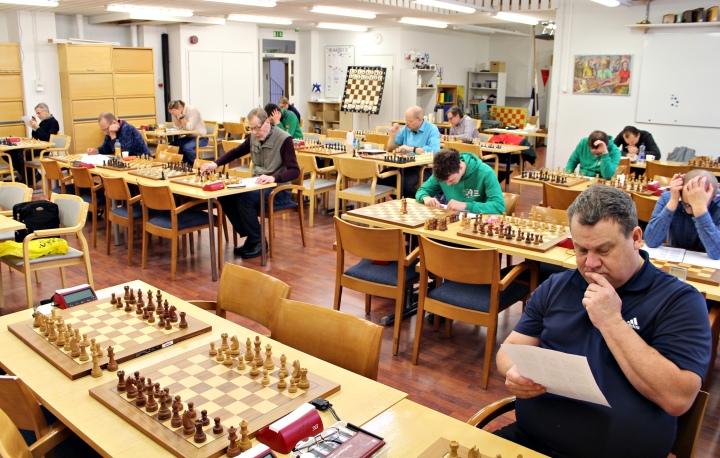
The 44th Finnish Championship in solving took place in the Chess Arena in Helsinki. The longtime director of the competition, Neal Turner, carefully selected the 12 problems to be solved within three hours. In solving competitions, the problems should not be just challenging; they must be of good quality, showing interesting and original ideas in an artistically satisfying way. The chosen problems met all these requirements, so Neal Turner did an excellent job! All 18 participants received points for their solutions and were also able to enjoy the beauty of chess compositions. Take, for instance, this mutual firework in two moves only: Mate in 2 moves The selection included two problems of each type: 2# (mate in two moves), 3#, more-movers (mate in four or more moves), endgame studies, helpmates and selfmates. The top finishers were close to the maximum of 60 points. For every correct solution, a solver received five points, but it was difficult to find all variations in the allotted time. Those who think a helpmate is easy to solve because Black helps to be mated may try the following problem from the competition in Helsinki: Helpmate in 2 moves (4 solutions) Black plays first and cooperates to be mated in the 2nd white move. As usual in helpmates, there are more intended solutions as parts of the overall concept. There is a powerful white battery Qa2-Nc4, suggesting it should be used for the mating move, but it gets paradoxically abandoned each time to create four other batteries. One of the solutions works this way: 1.Qb4! (Black has to take care of his own checking battery Qc5-Kd5) Rb3! 2.Kxc4 Rc3#. Can you find the other three solutions? In the close contest for the top honours, five solvers managed to score more than 50 points. Dutch GM solver Dolf Wissmann missed only 1.5 points and emerged as a deserved winner, ahead of two other GMs, Martynas Limontas of Lithuania and Jorma Paavilainen of Finland, who shared the 2nd place. Both netted an equal number of points and used the maximum time, but for the ex-World champion in solving Jorma Paavilainen, that was enough for the 11th domestic title, bringing him closer to the record holder with 14 Finnish titles, the multiple World Champion Pauli Perkonoja. Jorma Paavilainen (2nd-3rd), Dolf Wissmann (1st) and Martynas Limontas (2nd-3rd) Experienced Finnish IM Kari Karhunen, the holder of ten Finnish titles, finished only one point behind this duo, followed by the rising Lithuanian talent Kevinas Kuznecovas. Vidmantas Satkus, on the 6th place, rounded out a great performance by the Lithuanian squad. The youngest participant Kevinas Kuznecovas (18), was by far the fastest of all 18 solvers in Helsinki, using only 142 minutes. However, being that fast, he missed 5 out of 10 possible points in two endgames. For the maximal score in the following endgame, the solvers had to find all 13 White’s moves in a surprising King’s corner-to-corner walk! White to play and win Final standings: 1. Wissmann 58.5 points (166 minutes), 2-3. Limontas and Paavilainen 57 (180), 4. Jarhunen 56 (180), 5. Kuznecovas 54 (142), 6. Satkus 46 (180), 7. Tanner 43.5 (180), 8. Mockus 35 (180), etc. Is my solution correct? The strong Lithuanian team The best six solvers significantly rose in the overall standings of the World Solving Cup 2022/23: 1. Martynas Limontas (LTU) 29 points (+10 points), 2. Kevinas Kuznecovas (LTU) 17 (+4), 3. Arno Zude (GER) 16, 4. Dolf Wissmann (NED) 13 (+13), 5. Vidmantas Satkus (LTU) 12 (+2), etc. The next legs of the WSC 2022/23 will be the open championships of Poland (Sekocin Stary, March 4-5) and the Netherlands (Nunspeet, March 4). Solutions: Position 1 (Vjacheslav Kamenskij)1. Rg6! Position 2 (Fadil Abdurahmanovic)1.Qb4 Rb3 2.Kxc4 Rc3#1.Q×d4 Qb1 2.Ke4 R×d4#1.Qd6 Rc3 2.Kc6 Na5#1.Qe7 Qxb2 2.Ke6 d5# Position 3 (Aleksander Maskimovskic, Yu. Makletsov)1.Re7+ Kh8 2.Re8+ Kxh7 3.Rxe4 Ra1+ 4.Kxa1 bxc2 5.Re7+ Kh8 6.Rh7+ Kg8 7.Bc4+ Kf8 8.Rf7+ Ke8 9.Bb5+ Kd8 10.Rd7+ Kc8 11.Ba6+ Kb8 12.Rb7+ Ka8 13.Rb1 All 12 problems from the 44th Finnish solving championship Solutions with the distribution of the points Text: Marjan Kovačević, WFCC President Photos: Hannu Harkola Official website: wfcc.ch/
UPDATE: Fair Play Commission on the Carlsen/Niemann Report
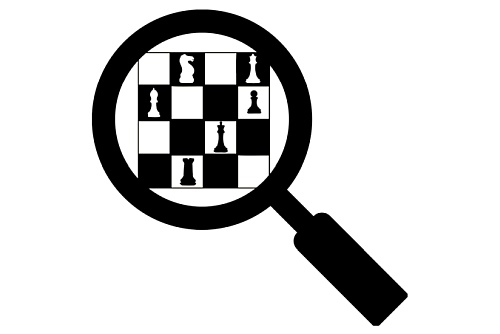
On February 17, the Fair Play Commission (FPL) unanimously adopted the report on the Carlsen/Niemann incident drafted by the Panel tasked with investigating the case, composed of Klaus Deventer (chair), Vincent Geeraets and Salomeja Zaksaite. On February 20, the 30-page report was forwarded to the Ethics and Disciplinary Commission (EDC) for further consideration. EDC’s nominated panel will assess the FPL’s findings and reach a decision on the case within six weeks. Pursuant to Art. 5 of the EDC Procedural Rules, until a decision is made, the contents of the Report shall be kept confidential to protect the procedure itself and all interested parties. Until then, no further comment on the matter shall be released by any FPL, EDC member, or any other FIDE official.
WR Chess Masters Round 6: Endgame battles
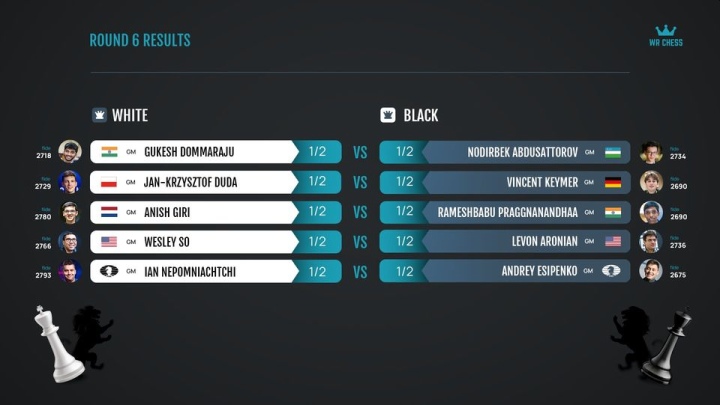
First against second: It could have been the game that made the tournament’s outcome completely uncertain again. Wesley So, one point behind, had to do nothing more than defeat Levon Aronian with the white pieces. Then both would have been back on level ground, and the field would have been close together. But the game ended in a draw – like the other four games of the sixth round, some of them after endgame battles lasting more than six hours. The standings are unchanged after this day of draws. Wesley So played a fighting game but didn’t come close to catching Levon Aronian. | Photo: Lennart Ootes Aronian was even close to almost deciding the tournament early. However, it would have required a computer-like solution, which So and Aronian missed. Instead of the computer maneuver, Levon played a very human one: transfer the knight from the edge back into the game. On the move after that, Aronian missed a very similar opportunity. After that, So did not again let the dynamic equilibrium of the sharp position out of his hands. In the end, Aronian forced a draw by perpetual check. Still in a comfortable situation with “plus three,” Aronian was not overly disappointed after the game. “I played a fighting game, and when you fight, you get chances,” Aronian explained in the interview. “But it’s also hard to avoid missing chances in the course of a tournament. The opponents are strong, it happens.” After the draw against So, Levon Aronian continues to lead the field with a one-point advantage, followed by Wesley So and Gukesh with 3.5 points each. The young Indian failed to capitalize on the opportunity to catch up half a point to the leaders in his white game. Gukesh and Nodirbek Abdusattorov played until the board was almost cleared. | Photo: Lennart Oootes After an English opening, Gukesh and Nodirbek Abdusattorov soon ended up in an even endgame in which the two white bishops were not superior to the two black knights. Which of the two played the balanced position to win? Probably not only the commentators Yasser Seirawan and Elisabeth Pähtz were wondering. One thing is certain: they played until the board was almost cleared, and the draw was inevitable. Ian Nepomniachtchi would have drawn level with the two runners-up with a win. After his series of draws, he now wanted to achieve this victory against Andrey Esipenko, not only on the board but also by psychological means. When Esipenko, after more than six hours and almost 80 moves, had worked out how to sacrifice his knight but eliminate all the white pawns in return and force a draw, Nepo suddenly had an intense facial expression. “He pulled a face like he pulls when his opponent has made a mistake,” Andrey Esipenko reported afterwards. And he told about his fear in the face of Nepomniachtchi’s grimaces, he had made a mistake. Esipenko: “I aged ten years in this game.” Andrey Esipenko (before ageing ten years). | Photo: Lennart Ootes Jan-Krzysztof Duda and Vincent Keymer played an Anti-Marshall, in which Keymer initially got good play after an original exchange sacrifice. Later he gave back the exchange, perhaps prematurely. The result was a stable but slightly inferior position for Black, where the Pole could play for a long time for two results. Duda tried his best for a good six hours, but Keymer held his ground. Praggnanandhaa was pressing from the opening against Anish Giri. He kept up the pressure deep into the endgame, where only the Indian was playing for a win despite being down an exchange thanks to his central passed pawn duo. Giri finally managed to take both passed pawns off the board by sacrificing the exchange back. The game ended in a bloodless queenside endgame with nothing to gain for either side. After the second time control, some observers were confused when they noticed that chief arbiter Gregor Johann had stopped the clock. Is it over? No, it was not. The players did not write down their moves in time trouble. While Giri and Pragg updated their sheets, Johann paused the clock according to FIDE rule 8.5.1. Elo 2800 when it comes to chess rules: Chief Arbiter Gregor Johann. | Photo: Lennart Ootes More photos and interviews in the tournament feed Text: Official website Photo: Lennart Ootes Offical website: wr-chess.com/

